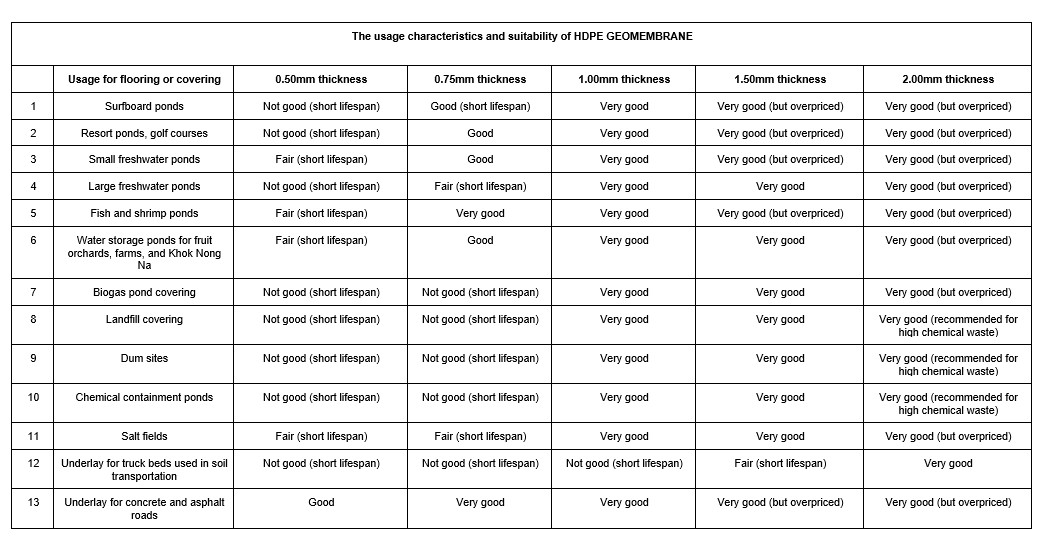HDPE Geomembrane is made from premium-grade plastic pellets, produced using modern machinery equipped with efficient production control technology.
TARA conducts inspections and quality control of products, from the receipt of pellets and during production to the final quality check before delivering to the clients. As a result, TARA's products meet international standards, including GRI-GM13 for HDPE sheets and GRI-GM17 for LDPE sheets.
TARA conducts inspections and quality control of products, from the receipt of pellets and during production to the final quality check before delivering to the clients. As a result, TARA's products meet international standards, including GRI-GM13 for HDPE sheets and GRI-GM17 for LDPE sheets.

HDPE SHEET Geomembrane
involves using HDPE plastic pellets that undergo a production process involving the compression molding of HDPE plastic pallets. This results in HDPE sheets with superior impermeability, commonly used in applications requiring liquid (or gas) containment. Depending on the project or system, the HDPE geomembrane is produced as a continuous, uniform polymer sheet. It can also be used as starting materials in the production of geotextiles with rubber or coated with polymers, leading to the creation of multi-layered geocomposites. Long, continuous strips of geomembranes are the most commonly used.
involves using HDPE plastic pellets that undergo a production process involving the compression molding of HDPE plastic pallets. This results in HDPE sheets with superior impermeability, commonly used in applications requiring liquid (or gas) containment. Depending on the project or system, the HDPE geomembrane is produced as a continuous, uniform polymer sheet. It can also be used as starting materials in the production of geotextiles with rubber or coated with polymers, leading to the creation of multi-layered geocomposites. Long, continuous strips of geomembranes are the most commonly used.

APPLICATIONS
- Water body lining for water storage, such as lining reservoirs, fish and shrimp ponds, or for agricultural purposes to improve terrain that cannot retain water, enabling agricultural development in dry areas.
- Chemical containment pit lining, as polyethylene is one of the most chemically resistant plastics.
- Lining inside water tanks for liquid and chemical storage.
- Agricultural compost pit lining which helps maintain the composting temperature and accelerates the process.
- Landfill lining, which prevents pollution from waste materials from spreading.
- Drainage channel lining for sewage treatment in golf courses, resorts, residential areas, etc.
- Water body lining for water storage, such as lining reservoirs, fish and shrimp ponds, or for agricultural purposes to improve terrain that cannot retain water, enabling agricultural development in dry areas.
- Chemical containment pit lining, as polyethylene is one of the most chemically resistant plastics.
- Lining inside water tanks for liquid and chemical storage.
- Agricultural compost pit lining which helps maintain the composting temperature and accelerates the process.
- Landfill lining, which prevents pollution from waste materials from spreading.
- Drainage channel lining for sewage treatment in golf courses, resorts, residential areas, etc.

Advantages of HDPE
- Ultraviolet resistance, chemical resistance, superior impermeability
- High tensile strength, high peel and shear resistance, high resistance to tearing and puncturing
- Long-term durability
- Ultraviolet resistance, chemical resistance, superior impermeability
- High tensile strength, high peel and shear resistance, high resistance to tearing and puncturing
- Long-term durability
PRODUCT SPECIFICATIONS
HDPE GEOMEMBRANE-SMOOTH
| Tested Property | Test Method | Standard Values | |||||||
| BNH050 | BNH075S | BNH075 | BNH100S | BNH100 | NBH150S | BNH150 | BNH200 | ||
| Thickness, mm Minimum average values Lowest individual reading | ASTM D5199 | 0.50 0.47 | 0.75 0.70 | 0.75 0.70 | 1.00 0.90 | 1.00 0.90 | 1.50 1.40 | 1.50 1.40 | 2.00 1.90 |
| Density, g/cm | ASTM D792 | ≥0.94 | ≥0.94 | ≥0.94 | ≥0.94 | ≥0.94 | ≥0.94 | ≥0.94 | ≥0.94 |
| Tensile Properties (each direction) Strength at Break, kN/m Strength at Yield, kN/m Elongation at Break, % Elongation at Yield, % | ASTM D6693 Dumbell Type IV | 14 9 700 13 | 23 12 700 13 | 23 12 700 13 | 33 17 700 13 | 33 17 700 13 | 48 25 700 13 | 48 25 700 13 | 65 35 700 13 |
| Tear Resistance, N | ASTM D1004 | 70 | 100 | 100 | 140 | 140 | 210 | 210 | 260 |
| Puncture Resistance, N | ASTM D4833 | 190 | 320 | 320 | 420 | 420 | 580 | 580 | 650 |
| Carbon Black Content % | ASTM D1603 | 2.0-3.0 | 2.0-3.0 | 2.0-3.0 | 2.0-3.0 | 2.0-3.0 | 2.0-3.0 | 2.0-3.0 | 2.0-3.0 |
| Carbon Black Dispersion | ASTM D5596 | Note.1 | Note.1 | Note.1 | Note.1 | Note.1 | Note.1 | Note.1 | Note.1 |
| Oxidative Induction Time, minutes | ASTM D3895 200*C:02.1atm | >100 | >100 | >100 | >100 | >100 | >100 | >100 | >100 |
| Typical Roll Dimentions | Standard Values | |||||||
| BNH050 | BNH075S | BNH075 | BNH100S | BNH100 | NBH150S | BNH150 | BNH200 | |
| Roll length, meter | 280 | 140 | 280 | 105 | 210 | 70 | 140 | 105 |
| Roll width, meter | 7.0 | 7.0 | 7.0 | 7.0 | 7.0 | 7.0 | 7.0 | 7.0 |
| Roll area, m? | 1960 | 980 | 1960 | 735 | 1470 | 490 | 980 | 735 |
NOTE:
1.Carbon black dispersion (only near spherical agglomerates) for 10 different views:9 in Categories 1 or 2 and 1 in Category 3
2. Roll Iengths and widths have a tolerance of +1%.

Powered by
MakeWebEasy.com